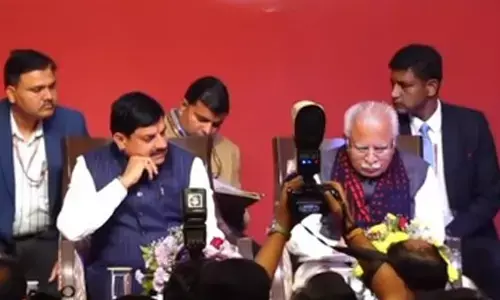Why the Rupee is falling?

The rupee has declined from Rs 64 to a dollar a year ago to Rs 71 presently and is expected to decline further in the coming months The core reason for this decline is the loss of competitiveness of the India economy Let us say a particular toy is being manufactured in the United States for one US Dollar The same toy is being manufactured in India in Rs 71
The rupee has declined from Rs 64 to a dollar a year ago to Rs 71 presently and is expected to decline further in the coming months. The core reason for this decline is the loss of competitiveness of the India economy. Let us say a particular toy is being manufactured in the United States for one US Dollar. The same toy is being manufactured in India in Rs 71.
Then the exchange rate of the rupee will be Rs 71 to a dollar because the same toy is available at this price in the two countries. It follows that if that toy could be produced in India in Rs 50, then the exchange rate would become Rs 50 to a dollar. The decline of the rupee means that India is losing competitiveness in the global markets.
Government policies have not helped. The Government is pushing the manufacturing sector though its “Make in India” campaign. Manufacturing requires ten times the energy than services such as tourism, software and health tourism.
The push to manufacturing is leading to an increase in our energy requirement. We are having to import large amounts of fuel oil. This is pushing our import bill and leading to an increase in the demand for dollars and to a decline in the rupee.
Every country must push those sectors that are suitable for its natural resources. Russia can grow by pushing energy-intensive industries, Brazil can be successful with water-intensive crops and African countries may be better with solar energy.
We have made the folly of pursuing energy-intensive manufacturing when we do not have large sources of energy, Countries like Singapore have attained high levels of income on the strength of the services sector. We must push services and reduce the energy consumption.
The Government policy of free trade has not helped either. The United States has imposed punitive import duties on steel exported from India. China has responded by imposing similar import duties on certain items imported from the United States. But we have been sitting like a lame duck and not taken any countervailing measure.
It is well known that China is preventing imports from India by resorting to non-tariff measures such as quality control. We have failed to take any measures here as well. The result is that our borders are open for imports from other countries while the borders of other countries are closing for us.
This is leading to low exports and high imports. We are earning progressively less amounts of dollars from exports while we need more amounts of dollars for imports. Our trade gap is expected to widen from 1.5 percent of GDP in 2017 to 2.5 Percent of GDP in 2019. This imbalance is leading to a decline in the value of the rupee.
The core reason for the decline of the rupee though is the loss of competitiveness. We could export larger amount of services such a health tourism and translation services. These are not hit by the trade barriers erected by the US and China.
But the tourist inflow to India remains laggard. We are also not able to export our goods to third countries where non-tariff barriers are not present because our cost of production is high. This fact is borne by the Global Competitiveness Report 2017-18 issued by the World Economic Forum (WEF). Our competitiveness rank from 39 in 2017 to 40 in 2018 (though it had improved from 71 in 2015).
This shows that the improvement brought about by the NDA Government in its first two years is faltering. So let us look at the reasons for loss of India’s competitiveness. The WEF has given a rank of 107/137 (107th rank in 137 countries) on “technological readiness” or the ability to use modern technologies such as the internet.
This low rank means that we have developed islands of technological excellence in software in Bengaluru and Pune but the larger economy is not able to migrate to latest technologies. The “forced” upgradation to e-platform under GST is not percolating to the use of e-technologies in the larger economy.
The WEF has given a rank of 91/137 in “health and primary education” and a rank of 75/137 in “higher education and training.” These low ranks indicate that our education system is still working in the colonial mode.
This low rank is also responsible for the low rank in “technological readiness” because the ability to absorb new technologies is not being developed in our educational system. Focus of the present Government, unfortunately, is on introducing Hindu agenda in the educational system instead of making its technological upgradation.
The WEF has undertaken a survey of executives to assess the most problematic factors for doing business. 92 percent of the executives mentioned corruption as the most important reason for difficulty in doing business. This indicates that while Prime Minister Modi may have cleaned up corruption at the higher echelons by appointing honest officers in key positions, the situation remains dismal at the ground level.
My conversations with businessmen indicate that the situation at the lower level has become much worse. Lower officials have upped the rates because senior officials are “honest.” The need was to implement systemic reforms to improve accountability of bureaucracy instead of relying on appointing honest persons alone.
The second factor was mentioned as lack of “access to finance.” The Public Sector Banks are mired in corruption and incompetence. The Government has continued to prop up these banks without, again, taking structural measures such as privatization. The Public Sector Banks are more concerned about saving their skins in a possible witch hunt rather than given loans and revving up the economy.
The third factor was mentioned as “tax rates.” This survey was undertaken after implementation of GST. This means that GST has not led to an effective reduction in tax rates as was expected.
The present fall of the rupee is not due to increase in the price of fuel oil because that could be countered by the development of the services sector. It is also not due to the trade war between China and America because we could impose high import duties. The causes of the decline are a result of the policies of the Government. So much for the fastest growing economy in the world! Author was formerly Professor of Economics at IIM Bengaluru
















